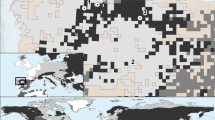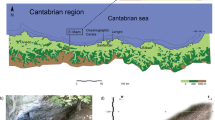Abstract
Opportunistic predator like the long-eared owl is able to respond to population fluctuations of its main prey. The composition of the winter diet of this owl species was investigated during the period of 13 winters (1992–2000, 2006–2011) in agricultural areas in Slovakia. In total, we found 23 mammal species and 33 bird species (H’ = 0.82) in pellets. The frequency of the dominant prey species, the common vole, varied from 57.7% to 92.4%. Our data show that the abundance of the common vole: (i) had biggest impact on the food niche breadth of the long-eared owl; (ii) when in decline, it was significantly compensated by the increase in the amount of 15 other accessory species (subject to the specific diet offered during the study winters); (iii) was positively correlated with the number of owls in the winter-roost, which varied during the 13 studied winters.
Similar content being viewed by others
References
Andersson, M. 1980. Nomadism and site tenacity as alternative reproductive tactics in birds. J. Anim. Ecol. 49 (1): 175–184. DOI: https://doi.org/10.2307/4282
Anděra, M. & Horáček, I. 2005. Poznáváme naše savce [We get to know our mammals]. Sobotáles, Praha, 327 pp. ISBN: 80-86817-08-3
Aschwanden, J., Birrer, S. & Jenni, L. 2005. Are ecological compensation areas attractive hunting sites for common kestrels (Falco tinnunculus) and Long-eared Owl (Asio otus)? J. Ornithol. 146 (3): 279–286. DOI: https://doi.org/10.1007/s10336-005-0090-9
Baláž I. & Ambros, M. 2006. Shrews (Sorex spp.) somatometry and reproduction in Slovakia. Biologia 61 (5): 611–620. DOI: https://doi.org/10.2478/s11756-006-0098-5
Baláž I., Ambros, M., Tulis, F., Veselovský T., Klimant, P. & Augustiničová G. 2013. Hlodavce a hmyzožravce Slovenska [Rodents and insectivores of Slovakia]. FPV UKF, Nitra, edícia Prírodovedec č. 547, [FNS KFU, edition Prírodovedec č. 547] Nitra, 198 pp. ISBN: 978-80-558-0437-8
Bethge, E. 1982. Zyklische Bestandswechsel (Gradationen) bei der Feldmaus (Microtus arvalis), festgestellt durch Analyse von Eulen–Gewöllen [Cyclic gradation of Common Vole (Microtus arvalis) determined by pellets analyses]. Z. Säugetierkunde 7: 215–219.
Birrer, S. 2009. Synthesis of 312 studies on the diet of the Longeared Owl Asio otus. Ardea 7: 615–624. DOI: https://doi.org/10.5253/078.097.0430
Bertolino, S., Ghiberti, E. & Perrone, A. 2001. Feeding ecology of Long-eared Owl (Asio otus) in northern Italy: is it a dietary specialist? Can. J. Zool. 79 (12): 2192–2198. DOI: https://doi.org/10.1139/z01-182
Cecere, J.G., Bombino, S. & Santangeli, A. 2013: Winter diet of Long-eared Owl Asio otus in a Mediterranean Fragmented Farmland. Wilson, J. Ornithol. 125 (3): 655–658. DOI: https://doi.org/10.1676/13-005.1
Galushin, V.M. 1974. Synchronous fluctuations in populations of some raptors and their prey. Ibis 116 (2): 127–134. DOI: https://doi.org/10.1111/j.1474-919X.1974.tb00232.x
Galeotti, P. & Canova, L. 1994. Winter diet of Long-eared owls (Asio otus) in the Po Plain (northern Italy). J. Raptor Res. 28 (4): 265–268.
Galeotti, P., Tavecchia, G. & Bonetti, A. 1997. Home-range and habitat use of Long-eared Owls in open farmland (Po plain, northern Italy), in relation to prey availability. J. Wild. Res. 2 (2): 137–145.
García, M., Cervena, F. & Rodríguez, A. 2005. Bat predation by Long-eared owl in Mediterranean and temperate regions of southern Europe. J. Raptor Res. 34 (4): 445–453.
Hagemeijer, W. J. M. & Blair, M. J. (eds). 1997. The EBCC Atlas of European Breeding Birds–Their Distribution and Abundance. T and AD Poyser, London, 903 pp. ISBN: 978-0-85661-091-2
Hudec, K. & Štastný K. (eds) 2005. Fauna ČR. Ptáci–Aves 2. Akademie věd ČR. Prague, 1203.pp. ISBN-3: 978-80-200-1113-8, ISBN: 80-200-1113-7
Huitu, O., Norrdahl, K. & Kormimäki, E. 2004. Competition, predation and interspecific synchrony in cyclic small mammal communities. Ecography 27 (2): 197–206. DOI: https://doi.org/10.1111/j.0906-7590.2003.03684.x
Jacob, J., Manson, P., Barfknechtc, R. & Fredricksd, T. 2013. Common Vole (Microtus arvalis) ecology and management: implications for risk assessment of plant protection products. Pest Manag. Sci. 70 (6): 869–878. DOI: https://doi.org/10.1002/ps.3695
Jacob, J. & Tkadlec, E. 2010. Rodent outbreaks in Europe: dynamics and damage, pp. 207–223. In: Singleton, G.R., Belmain S., Brown, P.R. & Hardy, B. (eds), Rodent Outbreaks: Ecology and Impacts, International Rice Research Institute, Los Banos, Philippines, 289 pp. ISBN: 978-971-22-0257-5
Kitowski, I. 2013. Winter diet of the barn owl (Tyto alba) and the long-eared owl (Asio otus) in Eastern Poland. North-West. J. Zool. 9 (1): 16–21.
Klein, R.G. & Cruz-Uribe, K. 1984. The Analysis of Animal Bones from Archaeological Sites. University of Chicago Press, Chicago, 273 pp. ISBN: 9780.26439587
Klok, C. & de Roos, A.M. 2007. Effects of vole fluctuations on the population dynamics of the barn owl Tyto alba. Acta Biotheoretica 55 (3): 227–241.DOI: https://doi.org/10.1007/s10441-007-9013-x
Korpimäki, E. 1992. Diet composition, prey choice and breeding success of Long-eared Owls: effect of multiannual fluctuations in food abundance. Can. J. Zool. 70 (12): 2373–2381. DOI: https://doi.org/10.1139/z92-319
Korpimäki, E. & Norrdahl, K. 1991. Numerical and functional responses of kestrels, short-eared owls, and longeared owls to vole densities. Ecology 2: 814–826. DOI: http://dx.doi.org/https://doi.org/10.2307/1940584
Korpimäki, E. & Sulkava, S. 1987. Diet and breeding performance of Ural Owls Strix uralensis under fluctuating food conditions. Ornis Fennica 64 (2): 57–66.
Kouba, M., Bartoš L. & Šťastný K. 2013. Differential movement patterns of juvenile tengmalms owls (Aegolius funereus) during the post-fledging dependence period in two years with contrasting prey abundance. PLoS ONE 8 (7): e67034. DOI: https://doi.org/10.1371/journal.pone.0067.34.
Kouba, M., Bartoš L. & Šťastný K. 2014. Factors affecting vocalization in tengmalm’s owl (Aegolius funereus) fledglings during post-fledging dependence period: Scramble competition or honest signalling of need? PLoS ONE 9(4): e95594. DOI: https://doi.org/10.1371/journal.pone.0095.94
Lambin, X., Bretagnolle, V. & Yoccoz, N.G. 2006. Vole population cycles in northern and southern Europe: is there a need for different explanations for single pattern? J. Anim. Ecol. 75 (2): 340–349. DOI: https://doi.org/10.1111/j.1365-2656.2006.01051.x
Lesi´nski, G. 2010. Long-term changes in abundance of bats as revealed by their frequency in tawny owls’ diet. Biologia 65 (4): 749–753. DOI: https://doi.org/10.2478/s11756-010-0074-y
Levins, R. 1968. Evolution in Changing Environments: Some Theoretical Explorations. In: Levin, S.A. & Horn, H.S. (series eds), Monographs in Population Biology, Princeton University Press, Princeton, 132 pp. ISBN: 9780.91080628
Mikkola, H. 1983. Owls of Europe. T & A. D. Poyser, Calton, Waterhouses, Staffordshire, England, UK, 397 pp. ISBN: 0-85661034-8.
Obuch, J. 1982. Náčrt potravnej ekológie sov (Striges) v strednej časti Turca [Outline of the diet ecology of owls (Striges) in central part of Turiec region]. Kmetianum 6: 81–106.
Obuch, J. 1989. Náčrt premenlivosti potravy myšiarky ušatej (Asio otus) [Outline of variability of Long-eared Owl diet]. (Asio otus). Tichodroma 2: 49–63.
Obuch, J. 1998. Zastúpenie netopierov (Chiroptera) v potrave sov (Strigiformes) na Slovensku [Bat abundance (Chiroptera) in the diet of Owl in Slovakia]. Vespertilio 3: 65–74. ISBN: 80-88850-19-3
Obuch, J. 2001. Využitie metódy výrazných odchýlok od priemeru (MDFM) pri vyhodnocovaní kontingenčných tabuliek. [Using marked differences from the mean (MDFM) method for evaluation of contingency tables]. Buteo 2: 37–46.
Pirovano A, Rubolini, D., Brambilla, S. & Ferrari, N. 2000. Winter diet of urban roosting Long-eared Owls Asio otus in northern Italy: the importance of the Brown Rat Rattus norvegicus. Bird Study 47 (2): 242–244. DOI: https://doi.org/10.1080/00063650009461181
Romanowski, J. & Z˙mihorski, M. 2008. Effect of season, weather and habitat on diet variation of a feeding specialist: a case study of the Long-eared Owl, Asio otus in Central Poland. Folia Zool. 57 (4): 411–419.
Rubolini, D., Pivovarno, A. & Borghi, S. 2003. Influence of seasonality, temperature and rainfall on the winter diet of the log-eared owl, Asio otus. Folia Zool. 52 (1): 67–76.
Sergio, F., Marchesi, L. & Pedrini, P. 2008. Density, diet and productivity of Long-eared Owls Asio otus in the Italian Alps: the importance of Microtus voles. Bird Study 5: 321–32.
Schmidt, E. 1975. Quantitative Untersuchungen an Kleinsäuger–Resten aus Waldohreulen–Gewöllen. Vertebr. Hung. 6: 77–83.
Schmidt, E. & Topal, G. 1971. Denevér maradványok magyarországi bagolyköpetekb˝ol [Presence of bats in owl pellets from Hungary]. Vertebr. Hung. 2: 93–102.
Shao, M. & Liu, N. 2006. The diet of the Long-eared Owls, Asio otus, in the desert of northwest China. J. Arid Environ. 65 (4): 673–676. DOI: https://doi.org/10.1016/j.jaridenv.2005.10.006
Sharikov, A.V. & Makarova, T.V. 2014. Weather conditions explain variation in the diet of Long-eared Owl at winter roost in central part of European Russia. Ornis Fennica 91 (2): 100–107.
Sharikov, A.V., Makarova, T.V. & Ganova, E.V. 2013. Long-term dynamics of Long-eared Owls Asio otus at a northern winter roost in European Russia. Ardea 101 (2): 171–176. DOI: http://dx.doi.org/https://doi.org/10.5253/078.101.0212
Sheffield, L.M., Crait, C.R., Edge, W.D. & Wang, G. 2001. Response of American kestrels and gray-tailed voles to vegetation height and supplemental perches. Can. J. Zool. 79 (3): 380–385. DOI: https://doi.org/10.1139/z00-220
Šálek, M. & Lövy, M. 2012. Spatial ecology and habitat selection of Little Owl Athene noctua during the breeding season in Central European farmland. Bird Conserv. Int. 22 (3): 328–338. DOI: https://doi.org/10.1017/S0959270911000268
StatSoft Inc. 2007. STATISTICA, version 8.0. https://doi.org/www.statsoft.com
Sundell, J., Huitu, O., Henttonen, H., Kaikusalo A, Korpimäki E., Pietiäinen, H., Saurola, P. & Hanski, I. 2004. Largescale spatial dynamics of vole populations in Finland revealed by the breeding success of vole-eating avian predators. J. Anim. Ecol. 73 (1): 167–178. DOI: https://doi.org/10.1111/j.1365-2656.2004.00795.x
Šipöcz, T. 2004. Zber. Databázový program. Verzia 3.0 [Collection. Database program. Version 3]. Botanical Garden, Comenius University, Blatnica.
Tome, D. 1991. Diet of the Long-eared Owl Asio otus in Yugoslavia. Ornis Fennica 68 (3): 114–118.
Tome, D. 1994. Diet composition of the Long-eared Owl in central Slovenia: Seasonal variation in prey use. J. Raptors Res. 28 (4): 253–258.
Tome, D. 2003. Functional response of the Long-eared Owl (Asio otus) to changing prey numbers: a 20-year study. Ornis Fennica 80 (2): 63–70.
Veselovský T., Tulis, F. & Baláž I. 2012. Kľúč na určovanie drobných cicavcov na základe kraniologických znakov [Key for small mammals determination on the basin of craniological features] FF UKF v Nitre, Nitra, 68 pp. ISBN: 978-80-558-0164-3
Wijnandts, H. 1984. Ecological energetics of the Long-eared Owl (Asio otus). Ardea 2: l–92.
Z˙mihorski, M., Romanowski, J. & Chylarecki, P. 2012. Environmental factors affecting the densities of owls in Polish farmland during 1980–2005. Biologia 67 (6): 1204–1210.DOI: https://doi.org/10.2478/s11756-012-0114-x
Author information
Authors and Affiliations
Corresponding author
Rights and permissions
About this article
Cite this article
Tulis, F., Baláž, M., Obuch, J. et al. Responses of the long-eared owl Asio otus diet and the numbers of wintering individuals to changing abundance of the common vole Microtus arvalis. Biologia 70, 667–673 (2015). https://doi.org/10.1515/biolog-2015-0074
Received:
Accepted:
Published:
Issue Date:
DOI: https://doi.org/10.1515/biolog-2015-0074




